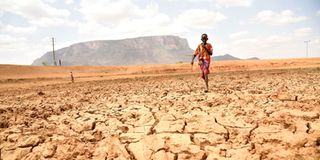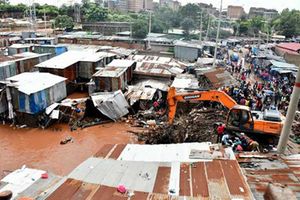Government has failed to adequately respond to disasters, says report

A herdsboy walks on a dry dam at Lerata in Samburu East. Samburu is had hit by drought but the county has stocked for distribution maize flour that was blacklisted for toxicity.
The government has consistently failed to adequately respond to disasters such as droughts despite investing billions of shillings over the past four years, leading to loss of lives and even livelihood for communities, a new report shows.
A report by the office of the Auditor-General says that despite attracting close to Sh24 billion in funding since 2015, the response and management of droughts – that is currently ravaging parts of the arid and semi-arid areas, has remained poor, leading to a perennial crisis that has become a yearly occurrence in the country.
The result has been the continual displacement of communities, death and heavy losses both for the affected communities and the country.
Auditor-General Nancy Gathungu, in a report done on the country’s management of droughts between 2015 and 2020, notes that drought management has become a complex system, involving many levels of government like the national and county as well as non-governmental organisations, a structure that has suffered both inadequate and ineffective coordination of response towards the management of droughts and other disasters.
Lasting solutions
Consequently, a failure by the government to address existing gaps in the management of droughts, has also worsened matters. The government, the report notes, has over the years failed to enact relevant laws and policies, act on early warning bulletins and also failed to involve affected communities in finding lasting solutions, resulting in crises that the report argues could otherwise have been avoided.
Further, communities in some of the worst hit areas, continue to remain vulnerable despite heavy investment in several projects aimed at strengthening climate resilience of communities, but which remain incomplete or failed to take off due to a lack of commitment or investment by the government. Some of the projects, the report notes, have also collapsed due to embezzlement of public funds and corruption.
“All the observed shortcomings were serious and affected the country’s level of drought preparedness. Moreover, contingency planning and response is a key component in drought management. Due to unclear guidelines, the contingency process is faced with planning deficiencies leading to delays during activation, hence putting lives and livelihoods at risk,” says the report.
“Besides, though intended to be used as a tool for early action, the audit has found a time lag during activation of contingency plans and lack of action on recommendations of the early warning bulletins, casting doubt on effective use of early warning information in the contingency processes.”
The audit was conducted following public concern on the government’s approach to drought management, expressed through discussions in Parliament and reports in the media, despite investment of billions of shillings towards the management of droughts.
For instance, since 2015, an estimated Sh24.6 billion has been sent to the National Drought Management Authority, but with little results or value for money achieved, according to the report.
The government has over the past couple of months come under heavy criticism over its response to the perennial droughts in the country. Some critics have also accused the government of sinking billions of taxpayers’ funds into projects aimed at addressing the droughts, but which have either collapsed or failed to materialise.
Construction of dams
For instance, while campaigning for the presidency in 2017, and even in 2013, President Kenyatta, alongside his deputy William Ruto had promised the construction of at least 57 dams, buy half of its food requirements from small scale farmers and improve forest cover from seven to 10 per cent in a bold food security plan, if re-elected.
The Jubilee team also promised to put under irrigation at least one million acres, partner with county governments to establish at least one agricultural produce market that they say will provide a central outlet for agricultural produce where farmers can sell directly rather than through middle men.
However, with less than a year to the end of his term, Mr Kenyatta is yet to see the full implementation of most of the said projects in the country, exposing thousands to the ravaging effects of disasters like famine.
The Jubilee administration also promised to create a Food Acquisition Programme, which they said will mandate the government to buy 50 per cent of its food requirements from small holder farmers.
“The audit observed limitations in the contingency system, which led to delayed drought response, putting communities’ lives and livelihoods at risk. Availability of relevant legislation would not only provide clear guidance on expected outcomes at each stage in the contingency process, but also ensure availability of funds for timely activation.
“In addition, fixed timelines for steps in activating the contingency plans could reduce delays during activation,” says the audit report.
A report by the National Drought Management Authority released this year said an estimated 2.1 million Kenyans face acute food shortage with the number expected to rise to 2.4 million during the October-December short rains, which the Meteorological Department has forecast to be below normal.
Counties facing the risk of severe drought are Baringo, Kajiado, Kwale, Laikipia, Lamu, Makueni, Meru, Taita Taveta, Tharaka Nithi and West Pokot while Embu, Narok and Nyeri are at a low risk.
Others on the drought alert are Garissa, Isiolo, Kitui, Mandera, Marsabit, Samburu, Turkana, Tana River and Wajir.
The audit however noted some significant positive developments by NDMA in drought management like the monthly early warning bulletins, in addition to the bi-annual food security assessment reports for each of the 23 counties. This has ensured continuous availability of information for decision-making.
“NDMA also worked closely with county planning units and National Government line ministries to mainstream drought risk management in government planning processes. NDMA has also developed a web-based Drought Contingency Fund system with the aim of ensuring timely disbursement of response funds,” the report says.





